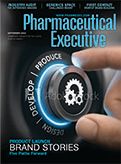Once Upon a Brand
Pharmaceutical Executive
The key ingredients for biopharma startups in building their brand story.
Whether you are Nike, Starbucks, or a life science startup, you have a story to tell. A story about the moment when the spark of inspiration and discovery shaped a disruptive therapy that could help change lives. But the truth is, many startups are still in a research phase, or pre-commercialization. They are filled with scientists or engineers eager to get the facts and the data out there to investors or key physician influencers. So, building a brand story may seem premature, and frankly, a bit fluffy. And yet, the brand story is the key to success. If you build it, with these four critical brand characteristics in mind, they will come: simplicity, personality, consistency, and authenticity.
Simplicity
It is quite common for companies to use thousands of words to describe where they came from, and what they do. But the concept behind it is really quite simple:
- There was a problem
- We solved it
- Success comes because of it
In short, your brand story should be simply and clearly told-“a short narrative that one could tell during an elevator ride.” But the challenge for many startups comes in determining what should be left out of the narrative. The key is to include only the compelling and differentiating points that keep the story moving. Simplicity breeds clarity, clarity breeds vision, and vision inspires multiple stakeholder audiences to want to be a “part” of the story.
Personality
We have all witnessed life science companies’ presentations to investors, usually fact-filled and data-driven. But sometimes, the presenter manages to connect the facts and the scientific points of difference by weaving in a distinct and ownable lexicon in a captivating way. This creates a personality, a personal voice for your brand. More companies are realizing the urgency of effectively communicating a story. It’s interesting to note that veteran actor Alan Alda is helping science professionals “communicate complex topics in clear, vivid, and engaging ways.” Remember, you yourself don’t have to be a “big” personality to build a brand story that has a personality.
Consistency
You might be surprised to learn that even with all the pre-market prep that goes into attracting investors, addressing KOLs, and appealing to practitioners and patients, the product brand storyline is often inconsistent, and the language used to express key ideas is not nailed down.
This happens because, in a life science startup, there are often different people presenting at different times, from the CEO to the CFO to the lead scientist. And without the boundaries of a brand story, there is a danger that each time someone describes the brand, they describe it differently than someone else in the same company. They might use different words, different key points, and not recount the story in the same way. Inconsistency leads to confusion about the brand and its purpose. To build a consistent story, the team must “define” and “align.”
While adept at explaining the science, life science companies don’t ordinarily micro-tune their messages using defined branding-a skill better suited to advertising agencies. Instead, their tendency is to rely on industry clichés and imprecise buzz phrases, such as “allowing for multiple shots on goal,” for example. So, in a sea of catch phrases, it’s critical to define the key messages to incorporate into your story, and the unique lexicon around your brand. To make this happen, the entire company must then align around that lexicon, and stay true to it. This is where advertising agencies can be an objective-and strategic support. Through exploratory workshops and brand foundation work, they bring key stakeholders together to ensure that there is a defining of the core messaging and true alignment around it.
Authenticity
By nature, life science companies are grounded in storytelling. It’s inherent in the scientific process to develop a hypothesis and prove it. So already, life science startups come from an authentic desire to tell a story that makes a difference. That authenticity should be in the DNA of every brand story. Authenticity builds trust. Many stories end up feeling like sales pitches, filled with marketing jargon and benefit bullet points. But it’s the simple, personal, and consistent story that screams authenticity. For a brand story to truly engage and inspire, it needs to have an authentic voice-not from one individual, but from the entire organization.


Robert Finkel is CEO and Patricia Malone is Chief Creative Officer, both with FreshBlood Group

The Misinformation Maze: Navigating Public Health in the Digital Age
March 11th 2025Jennifer Butler, chief commercial officer of Pleio, discusses misinformation's threat to public health, where patients are turning for trustworthy health information, the industry's pivot to peer-to-patient strategies to educate patients, and more.
Navigating Distrust: Pharma in the Age of Social Media
February 18th 2025Ian Baer, Founder and CEO of Sooth, discusses how the growing distrust in social media will impact industry marketing strategies and the relationships between pharmaceutical companies and the patients they aim to serve. He also explains dark social, how to combat misinformation, closing the trust gap, and more.